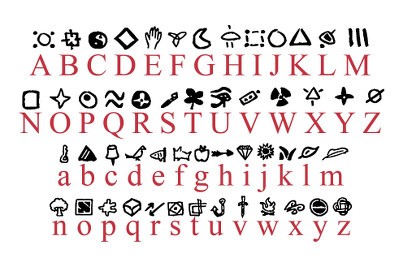Having today had a closer look at the eighteen Weldon ciphers found so far, I have to say that there’s not quite as much cryptographic meat to chew as it initially seemed. In fact, there are exactly three different cryptograms, with only minor variations from those in the others.
So, here’s Chris Demwell’s original transcription for Note 01, along with my transcriptions for Notes 02 and 03, and descriptions of the differences between these and the fifteen other notes:-
* Note 01
threecircle leaf bubble dog apple dotsquare yinyang target square clover key bird hatch arrow
circle dotblob triangle clover threecircle fire cube bidirection sunfish pacman target three ra flux
arrow sun earth dotblob floyd diamond grass key apple bubble dotcircle ra target pacman star
apple hook yinyang clover triangle bird ra square brush dotsquare three bigstar bubble waves
target ra triangle dotcircle phi star grass leaf threecircle star diamond threecircle circle desktop
bidirection dotblob tack sun dotcircle threecircle circle ra fire dotsquare bigstar cube key leaf
dotsquare phi bubble splitcircle leaf feather floyd brush circle triangle star remote pacman remote
dotcircle threecircle gem frame triangle square trefoil
puzzlepiece bird apple arrow yinyang feather dotblob
bigstar tack apple star ra brush square
leaf hand threecircle bubble dotcircle phi sun
* Note 02
gem cube tree bird feather leaf key desktop ra dotsquare bubble square arrow grass star
hand sun desktop feather cube atomic ra star earth hand bigstar brush diamond apple key
tree feather cube phi flux dotsquare puzzlepiece frame arrow hatch dotblob ra cube key hook
square triangle waves dotcircle gem leaf gem waves threecircle earth clover phi bubble dotcircle
hook bird cube feather bidirection hook knot bigstar atomix bubble three square trefoil dotsquare bigstar
bird arrow dog dotblob hand triangle three yinyang hand waves atomic bigstar threecircle circle
dotsquare bigstar bubble sunfish leaf key hook gem gem
feather earth phi dotcircle desktop fire waves splitcircle
triangle leaf square remote hand arrow apple grass
threecircle dotblob feather target gem pacman threecircle dotcircle
gem phi triangle dotcircle bubble apple bird puzzlepiece
* Note 03
circle desktop bird leaf dotblob frame cube gem fire floyd tree feather tack knot foam
dagger key cube waves atomic three square bigstar bubble grass knot foam puzzlepiece dog pacman
threecircle dotcircle ra yinyang gem hatch cube floyd tack bird brush clover earth dotsquare
circle square flux hand dotblob dotcircle triangle waves dotcircle triangle trefoil dotsquare hand yinyang
square target remote circle yinyang star trefoil flux frame tree foam frame floyd feather fire
cube hook dotblob desktop feather circle brush three atomic feather desktop gem bubble brush square
target sunfish dotblob dotsquare grass bird pacman threecircle game dotsquare ra puzzlepiece waves atomic
star square yinyang waves square target dotcircle
bigstar three cube feather arrow apple sun leaf
bird desktop splitcircle puzzlepiece threecircle tree bigstar dotsquare
feather threecircle square arrow target three earth
* Note 04 = Note 03, but “square arrow target three earth” at the end replaced with “frame puzzlepiece”.
* Note 05 = Note 02
* Note 06 = Note 02, but with two extra symbols (“triangle waves”)
* Note 07 = Note 03
* Note 08 = Note 03, but “square arrow target three earth” at the end replaced with “frame puzzlepiece”.
* Note 09 = Note 02, but missing the final two symbols
* Note 10 = Note 02
* Note 11 = Note 03, but “square arrow target three earth” at the end replaced with “frame puzzlepiece”.
* Note 12 = Note 03
* Note 13 = Note 02, but missing the final six symbols
* Note 14 = Note 02, but with two extra symbols (“triangle waves”)
* Note 15 = Note 02
* Note 16 = Note 03
* Note 17 = Note 03, but missing the final five symbols
* Note 18 = Note 01
From the way that the text flows around the slightly different-shaped pictures, it seems likely to me that this was done in a straightforward word processor (say, Microsoft Word) with a custom font, text flowing left-to-right and top-to-bottom (as per normal). Also, even though I haven’t counted, my guess is that there are no more than 52 different shapes used in the three core cryptograms, which would seem to point to A-Z and a-z having been used.
Anybody want to have a go at cracking these? 🙂

